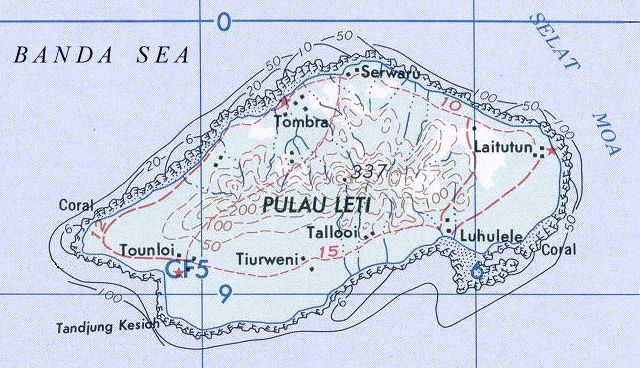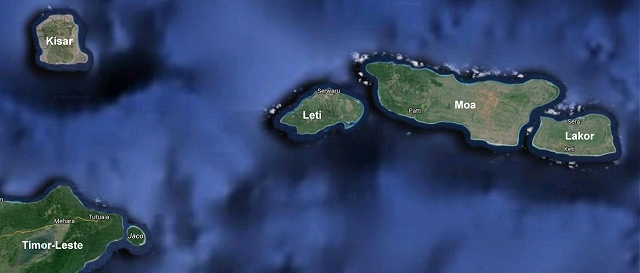Few extant examples, precious little firm knowledgeThe closely packed Leti Islands – Leti, Moa and Lakor – lie just to the East of East-Timor, and culturally can seem like an extension of the big island, though they also have developed cultural traits that are entirely their own. Their most important myth of origin is the sailfish tale centred on Luang, told here with only minor variation. The chief deity is (or was, before Christianity arrived) the Sun God, Upu-Lero, who is not identified with the heavenly body, but resides there. Each year during the east monsoon he comes down to earth into a banyan tree and there mates with the Earth Goddess, Upu-Num, to bring fertility to the islands. "Formerly at this time the men and women of the islands had promiscuous sexual intercourse for a month." Which goes a long way to explain the popularity of the original belief, and must have constituted a true challenge for the sainted missionaries to repress.So few examples of older ikat textiles from the Leti Islands are extant, and so little is known about them that it is hard even to achieve reliable identification of provenance – a recurring issue in the 'Forgotten Islands'. Of the four 19th and early 20th C. sarongs in the Amsterdam Tropenmuseum one shows a strong similarity with the sarongs of Kisar and especially Luang, rimanu motifs in white on indigo decorating the main ikated bands; one shows similarity with the type of Kisar sarong exemplified by PC 138 but is much shorter; two are decorated with a few narrow ikated bands and stripes with basic snaking and small dotted motifs. All have a reddish overtone. The four men's loincloths from the same period are all bright red, patently dyed with synthetic dyes, and have narrow longitudinal bands with small ikated motifs. In overall appearance they are somewhat similar to men's loincloths from Kisar. There were strict prescriptions ruling their use: men belonging to the lowest two classes, ate and wusuru could only wear the front end very short – a debasing rule leaving them at constant risk of exposure of their private parts. The Tropenmuseum also has two fragmentary pieces identified as kain timur (see Seram), intended for the trade with New Guinea. Their main motifs are similar to some Kisar motifs; striking is the use of solid red bands, similar to those in our sarong PC 195 that is tentatively identified as Leti. Given the cultural interwovenness of the islands, establishing whether an ikat cloth has been made on Leti, Moa or Lakor, is generally impossible without access to the source. Three ikat cloths for each householdIkat is still important for social life on the Leti Islands. It is part of traditional attire required for cultural events, and is the expected gift for closely related families suffering bereavement. The more cloths are received, the higher the social status of the deceased – and of the surviving family members. All the gifts join the deceased in the grave to provide for him or her in the hereafter. The cloths one gives at a funeral come in three distinct types, differentiated by their purpose: the first is provided by the deceased's family and serves as a mat for the body; the second type is brought by family members family and draped over the body inside the coffin, the third is given to wipe the tears of the deceased’s wife or mother. To be prepared for eventualities, every household on the Leti Islands is honour-bound to keep at least three completed ikat cloths.This requirement strengthens the already powerful position of women. Descent is matrilineal, with special reverence given to the female founding ancestor. In the homes of leading families stand ornate wooden altars, luli, that depict the ancestral mother bare-breasted with outstretched arms. (In fact few of them stand there anymore as they are sold at Christies and Sotheby's at six figure hammer prices.) The outstretched arms recall the rimanu figures arms found on the sarongs of Leti, Kisar and Luang, and it is tempting to see a link, but to the author's knowledge it has not been established whether the human rimanu figures are male of female. Van Engelenhoven explains that artefacts such as ikat textiles served to support memorisation of traditional narratives: "The worldwide admired handicraft of the islanders, the statues, the textiles and the goldsmithry primarily functioned as a means to fixate the motifs and ornaments with which the narratives were memorized. In this perception it is understandable that these artefacts whose importance was well acknowledged by the islanders, were easily sold or bartered (Jacobsen 1896). The artefacts themselves could be easily replaced by new made ones. The rou [traditional motif charged with meaning whose 'copyright' was exclusively reserves for the proprietor-clan], however, being the counterparts of names on artefacts, were not for sale." "The only medium to transmit knowledge on rou appears to be traditional textiles, which are still very much favoured in the region. Women, to whom weaving has traditionally assigned to, still learn how to make the motifs and dye them onto the cloth. The link, however, between the name of a rou and the 'narrative chunk' that goes with it has been lost." This means that in terms of cultural development the Leti, Moa and Lakor are 'normal' islands in the Indonesian archipelago, as the same is happening almost everywhere else: the patterns remain, but what they stand for disappears from the collective memory – a process that constitutes an irretrievable loss not just for the islanders, but for mankind. We still look at these pieces, but as time goes by we know progressively less about what they mean. Being conscious of this development should spur us on to document what we can and preserve not just the material objects, but also whatever knowledge we may possess about their meaning. Vitality springing from a barren islandThe author has never encountered an ikat attributed specifically to Moa, the middle of the three Leti Islands, but in the early 1980s could acquire one sarong with a firm Lakor provenance. Lakor, the most easterly islet in the group, is made of hard coral and limestone, about 16 km long by 7 km wide, and has eight villages. The infertile soil is partly overgrown with low shrub; some small plots allow subsistence agriculture. There are no sources of fresh water on the island, but according to a Dutch naval officer who visited Lakor in 1826, the islanders conserved rainwater in limestone pits where it kept reasonably well, a practice that presumably has been carried on. He also observed coconut palms, which must have helped quench the islanders' thirst.What fascinates us about tiny specks in the ocean such as this, is how people manage to survive there, and develop artisanal skills. One can only be deeply in awe of such fellow human beings, who battle for existence in a zone where the dry season that lasts for months, so that both agriculture and raising livestock are difficult; where fish – to be caught in a sea that is notoriously treacherous – is nearly the only source of animal protein; and where there are practically no opportunities for trade. As for medical care: "...every year, generally in March, the people of Leti, Moa, and Lakor, islands of the Indian Archipelago, send away all their diseases to sea. They make a prahu about six feet long, rig it with sails, oars, rudder, and other gear, and every family deposits in its some rice, fruit, a fowl, two eggs, insects that ravage the fields, and so on. Then they let it drift away to sea, saying, 'Take away from here all kinds of sickness, take them to other islands, to other lands, distribute them in places that lie eastward, where the sun rises.'" By now some medical aid must has arrived on the islands, but given the poor state of health care on several much larger islands, it is certain to be elementary. Given these facts of life one would expect any textiles produced on the island to be extremely basic, and of a sombre tonality. Yet as our one rare specimen shows – the only ikat textile from this island that ever encountered anywhere – both the design and the weaving are on a par with that of larger and much less remote islands such as Adonara and Alor, and the coloration is unequivocally cheery. Remarkably, even here in this remote outpost at the very extremity of the Indonesian archipelago, we see the influence of Indian patola trade cloths in the design: the main ikated bands of this one cloth end in small triangular tumpal motifs. |



